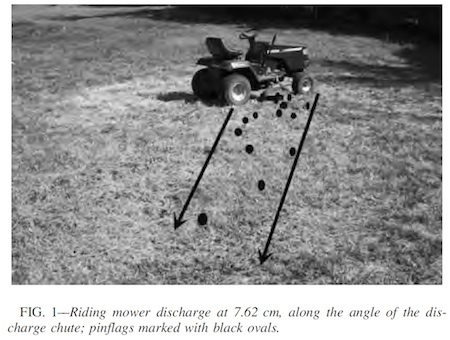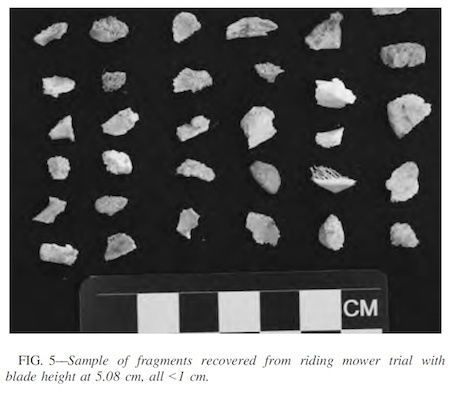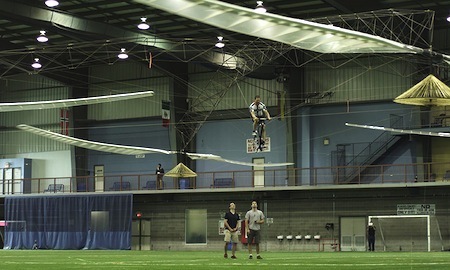Marc Abrahams's Blog, page 478
July 13, 2013
A love-ly code: The Cupid Stamp Lovers’ Code
The Tower Project Blog explores, a bit, a love-ly code:
This pamphlet Cupid’s code for the transmission of secret messages by means of the language of postage stamps by Bury George:
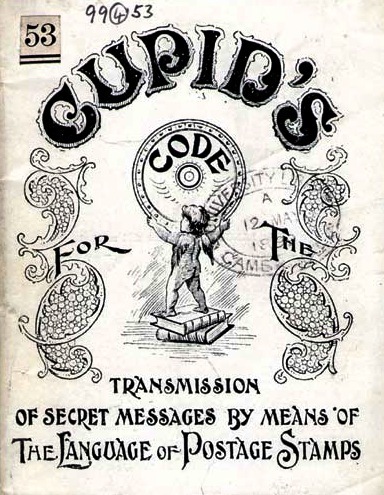
The code uses the position and orientation of the stamp – with eight positions and eight orientations there are 64 basic messages – or 128 if two stamps were used. The messages are printed in perforated strips, and can be re-arranged, giving according to the author “close upon 270,000 different ways, so that no attempt to discover any particular combination could possible succeed.” The code books were sold in pairs,and it was even possible to buy a specially arranged duplicate code “guaranteed non-existent elsewhere” for the bargain sum of 6 shillings.
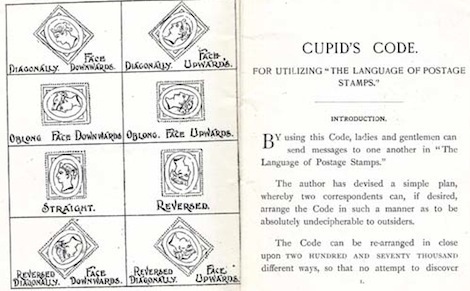
(Thanks to investigator Lila Dalton for bringing this to our attention.)

Effect of Passing Lawn Mowers over Skeletal Remains [study]
Of the forensic studies of the effect of passing lawn mowers over skeletal remains, this is the most recent:
“Lemonade from Lemons: The Taphonomic Effect of Lawn Mowers on Skeletal Remains,” D.C. Martin, Gretchen R. Dabbs [pictured here], Lindsey G. Roberts, Journal of Forensic Sciences, epub July 3, 2013. (Thanks to investigator Rolf Zwaan for bringing this to our attention.) The authors, at Southern Illinois University, report:
“This study provides a descriptive analysis of the taphonomic changes produced by passing over skeletonized remains (n = 4, Sus scrofa) with three common lawn mowers. Two skeletons were mowed over with a riding lawn mower set at multiple blade heights (10.16, 7.62, 5.08 cm) and one each with a rotary mower (9.53, 6.35 cm) and a mulching mower (6.35 cm). Results show that different types of common lawn mowers will produce different patterns of bone dispersal and fragmentation rates. Overall, skeletal elements projecting upward from the surface frequently exhibited a sheared morphology characterized by a smooth, flat, cut surface (7.0-7.6% of elements). The push mowers yielded a higher frequency of undamaged bone than the riding mower (54.8-61.2% vs. 17.7%), and the riding mower created more catastrophic damage to skeletal elements. Additionally, each mower produced a distinct dispersal pattern of skeletal fragments. The dispersal patterns have been identified as “bull’s-eye” (riding), circular (mulching), and discontinuous rectangle (rotary).”
Some details from the paper:
BONUS (unrelated): Video of mowing with a murder of crows:

Simple-Logic Essay Competition: Finger-length paper
Here’s this weeks’s Simple-Logic Essay Competition.
In clear simple sentences, describe the chain of logic for this academic paper:
“Correction for van Honk et al., ‘Testosterone administration impairs cognitive empathy in women depending on second-to-fourth digit ratio‘” [Proc Natl Acad Sci U S A. 2013 Jun 17]
COMPETITION RULE: Your simple, clear explanation must be , at most, 40,000 words long.
—————————————
BONUS (unrelated): Here is a photo of van Honk:

The Three Dimensions of Fresh Air
 The Journal of Material Culture is “concerned with the relationship between artefacts and social relations irrespective of time and place”. And, as part of this remit, the June 2013 issue of features one of the few academic studies of ‘Fresh Air’. ‘The air from outside: Getting to know the world through air practices’.
The Journal of Material Culture is “concerned with the relationship between artefacts and social relations irrespective of time and place”. And, as part of this remit, the June 2013 issue of features one of the few academic studies of ‘Fresh Air’. ‘The air from outside: Getting to know the world through air practices’.
“The article begins by showing air as an integrative practice with three dimensions: functional, bodily/sensory and social. It is shown how knowledge of the environment is constructed in the process of ‘practising’ air, how this knowledge is transferred into a sense of being-in-the-world and how emotions are part of this becoming.”
Non-subscribers can download the article for US$25.00. But considerable background on Fresh Air studies can be read free-of-charge via the Dept. of Sociology at Copenhagen University. Where author Bettina Hauge, MSc (anthropology), PhD, post.doc. provides a copy of a similarly-entitled article : ‘The Significance of Fresh Air from Outside: Getting to know the World through Air’.
“This qualitative study focus on the immaterial, sensuous and invisible phenomenon: Fresh air from the outside and into the home („FAFOH‟), and the practices involved with this – what people do with air.”
The author’s FAFOH approach showed that :
“„Fresh air from outside‟ has been found to be much more than „fresh‟ or „air‟, it has its own sociality that goes beyond the technical understanding of fresh air. Fresh air is a profound link to our experience of being and feeling alive as a human being.”
Also available:
• English and Scottish Fresh Air (2010)
QUESTION : The studies revealed an unusual detail regarding possible gender-based differences in letting-in or keeping-out Fresh Air (or letting-out or keeping-in Stale Air).
“It seems like the FAFOH field has ‘Openers’ (mostly women) and ‘Closers’ (mostly men).”
This appears to be an as-yet-underexplained phenomenon. Readers’ hypotheses are welcome (as always).

July 12, 2013
“How to Think, Say, or Do Precisely the Worst Thing”
If one wanted to think, say, or do precisely the worst thing, how would he or she go about doing so? This paper looks into that question:
“How to Think, Say, or Do Precisely the Worst Thing for Any Occasion,” Daniel M. Wegner [pictured here], Science, vol. 325, July 3, 2009, pp. 48-50. The author, intentionally or not at Harvard University, begins:
“There are many kinds of errors. We can fall short, overreach, or skitter off the edge, of course, but we can also miss by a mile, take our eyes off the prize, throw the baby out with the bath water—and otherwise foul up in a disturbingly wide variety of ways. Standing out in this assortment of would-be wreckage, though, is one kind of error that is special: the precisely counterintentional error. This is when we manage to do the worst possible thing, the blunder so outrageous that we think about it in advance and resolve not to let that happen.
“And then it does…
Elsewhere, Wegman looks at other questions, including this one: “How do we know when something has a mind? We’re fairly certain that rocks and beer cans don’t, of course, and most of us are also convinced that we ourselves have minds–but what about the gray areas?”
Alas, Professor Wegner passed on recently. Brian Marquard of the Boston Globe wrote an appreciation of him.
(Thanks to Carolyn Johnson for bringing this to our attention.)
BONUS: Professor Wegner’s web page of pictures of monsters carrying women
BONUS: Professor Wegner’s “Hidden Brain Damage Scale“, of which he wrote: “Of the many psychometric devices designed to measure the dimensions of human variation, the Hidden Brain Damage Scale stands alone as the only instrument capable of predicting preference for pimento loaf.”

A classic 24/7 Lecture: Benoit Mandelbrot — FRACTALS
Benoit Mandelbrot delivered one of the very early 24/7 Lectures. A 24/7 Lecture is a lecture in two parts: first a complete technical description in 24 seconds, second a simple description anyone can understand in 7 words.
At the 2006 Ig Nobel Prize Ceremony, Professor Mandelbrot spoke on the topic: FRACTALS. His seven-word summary has become a classic definition of the genome, against which all others are measured.
Here’s video of that historic moment:
BONUS: The 24/7 Lectures have been a featured part of every Ig Nobel Prize Ceremony since 2001. This year’s ceremony, on September 12, 2013, will include several new 24/7 Lectures, each written and performed by one of the world’s great thinkers.
BONUS: Dany Adams’s classic 24/7 Lecture on BIOLOGY
BONUS: Eric Lander’s classic 24/7 Lecture on THE HUMAN GENOME
BONUS: Other Improbable Research videos

July 11, 2013
Heli Man —
Add/blend together Leonardo da Vinci, Igor Sikorsky, Rube Goldberg, and Eddie Merckx, and if you are very, very good and very lucky, you get something like this:
AeroVelo Officially Awarded AHS Sikorsky Prize!
Posted on July 11, 2013 by Cameron in BlogGreat news! The American Helicopter Society has officially declared AeroVelo winner of the Igor I. Sikorsky Human Powered Helicopter Competition. After a thorough and rigorous independent analysis of the flight data of June 13th 2013 12:43 EDT, the AHS Human-Powered Helicopter Committee concluded that indeed Atlas’ epic flight 1) exceeded 60 seconds duration, 2) exceeded 3m in height, and 3) remained within a 10m x 10m box….
Go to the AeroVelo site to see the short, impressive video in large, glorious form.
(Thanks to investigator Ella Ewell for bringing this to our attention.)

Chin Up, Testicularly
Body parts can be rearranged and/or augmented, in some cases. Here is such a case:
“Testicular Augmentation Using Chin Implants,” Fernando Ugarte y Romano [pictured here] and Adolfo González Serrano, Journal of Sexual Medicine, epub October 22, 2012. The authors, at Universidad Nacional Autónoma de México, México, México, report:
“Aim. To describe an unprecedented testicular augmentation surgical technique that is specially focused on preserving testicular function and providing a favorable esthetic outcome.
“Methods. We present a case of a 45-year-old man with body dysmorphic disorder. Surgical treatment using a new technique by placing a chin implant on the testicle was offered and accepted.
“Results. Good symmetry between both testicles was achieved. No complications were reported….
“Conclusions. This technique is unprecedented in literature…”
Here is detail from the study:
(Thanks to investigator Holly Brothers for bringing this to our attention.)
BONUS: Dr. Paul Massif asks and answers the question “What Is a Chin Implant?”:
BONUS: A performance of the song “Keep Your Chin Up”:

A classic 24/7 Lecture: Eric Lander — THE HUMAN GENOME
Eric Lander delivered one of the early 24/7 Lectures. A 24/7 Lecture is a lecture in two parts: first a complete technical description in 24 seconds, second a simple description anyone can understand in 7 words.
At the 2003 Ig Nobel Ceremony, Professor Lander spoke on the topic: THE HUMAN GENOME. His seven-word summary has become a classic definition of the genome, against which all others are measured.
Here’s video of that historic moment:
BONUS: Dany Adams’s classic 24/7 Lecture on BIOLOGY
BONUS: The 24/7 Lectures have been a featured part of every Ig Nobel Prize Ceremony since 2001. This year’s ceremony, on September 12, 2013, will include several new 24/7 Lectures, each written and performed by one of the world’s great thinkers.
BONUS: Other Improbable Research videos

July 10, 2013
A classic 24/7 lecture: Dany Adams — BIOLOGY
Dany Adams delivered one of the very first 24/7 Lectures. A 24/7 Lecture is a lecture in two parts: first a complete technical description in 24 seconds, second a simple description anyone can understand in 7 words.
At the 2001 Ig Nobel Ceremony, Professor Adams spoke on the topic: BIOLOGY. Her seven-word summary has become a classic definition of biology, against which all others are measured.
Here’s video of that historic moment:
BONUS: The 24/7 Lectures have been a featured part of every Ig Nobel Prize Ceremony since 2001. This year’s ceremony, on September 12, 2013, will include several new 24/7 Lectures, each written and performed by one of the world’s great thinkers.
BONUS: Other Improbable Research videos

Marc Abrahams's Blog
- Marc Abrahams's profile
- 14 followers


